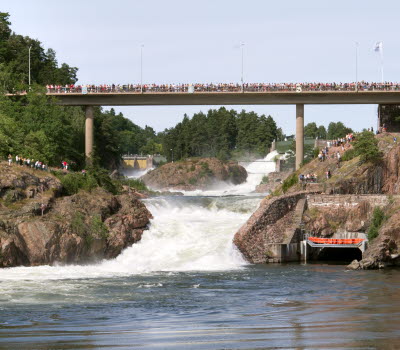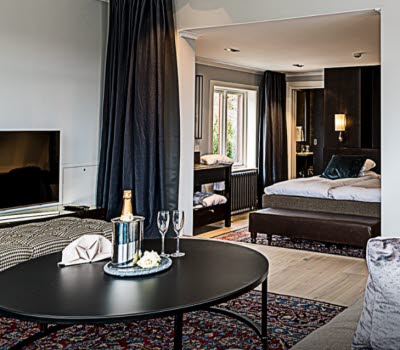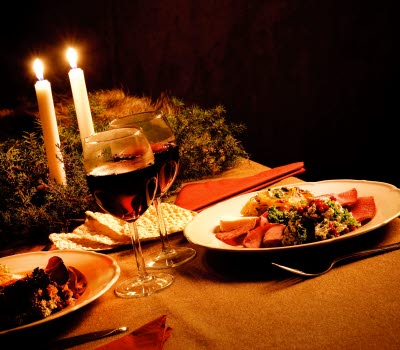Dendro safari
Trollhättan
Trees give us humans several ecosystem services such as taking care of stormwater, clean the air we breathe, even out temperatures in the air and on the ground, reduce mental illness and not to forget - adorn our public spaces!
The Dendro safari takes you on a journey through the city's central parts and its scenic parks. Get around the walk as you like, or split it up into several lovely walks. We suggest starting the journey at Karl Johans torg square and ending it at the Drottningtorget square. Take the opportunity to sit down for a while and look at the many plantings, read about Trollhättan's history along the path that stretches across the square and look at the fountain Trollkällan.
Walk, jog, use a wheelchair or cycle and feel free to share your best park experience! #visittv
A folder with a map and information about the walk can be picked up at Trollhättan's City Hall and at Trollhättan's Tourist Office
1 - Corylus colurna - Turkish hazel
Karl Johans torg square
The tree is naturally occurring in the area from the Balkans, via northern Turkey to northern Iran. Gets about 20 meters high and often has a straight, continuous trunk with more or less horizontal branches and produce edible nuts surrounded by a thick, softly spiny and bristly husk. During the summer, but also during the winter, it provides a heavy shading as both the foliage and the branches are dense.
Spring - nothing special
Summer - beautiful habitus with its pyramidal shape
Autumn - autumn colors in yellow-green, fruit surrounded by a thick, softly spiny and bristly husk
Winter - beautiful habitus
2 - Magnolia spp. - Magnolia
Karl Johans torg square
Spp. stands for species, which is usually stated if you do not know exactly which species it is or if you are referring to several species within the same genus. In Trollhättan you can find magnolia in several places. You will surely discover different varieties with different habitus and different flowers on this dendro safari. This magnolia is one of the largest found in Trollhättan on public land and is usually overflowed with flowers from around late April to mid-May, depending on the weather. This variety gets tulip-like flowers that are about 20 centimeters high in pink that change to light pink/white at the top.
Spring - flowers on bare twig, magnolia has one of the most magnificent bloomings
Summer - fairly anonymous, healthy green leaves
Autumn - autumn colors in yellow-brown, certain species get decorative fruits
Winter - nothing special, but buds for next year's blooming give a certain ornamental value
3 - Liriodendron tulipifera - American tulip tree
Spikön Island
The tree originates from eastern North America where it can grow in large forest stands. Gets around 15-20 meters high and 8-10 meters wide. The leaves are easy to recognize, they look almost like a silhouette of a tulip spreading its petals. The tulip tree get yellow flowers with an orange band on the tepals and even they look like a tulip flower. The flowers initially have greenish-white sepals and they often sit high up in the tree, which can make it difficult to see the flowers. It often also takes 10-15 years before a tulip tree begins to have flowers.
Spring - newly developed leaves are beautifully shiny and light green
Summer - exciting leaf shape, beautiful flowers although difficult to see sometimes
Autumn - autumn colors in gold/yellow
Winter - nothing special
Photographer: Trollhättans Stad
4 - Abies koreana - Korean fir
Spikön Island
The Korean fir belongs to the genus spruce (Abies). The Korean fir grows 5–7 meters high and 2–3 meters wide after about 25 years. So it grows quite slowly. As the name suggests, the Korean fir has its origins in South Korea. The fir needles are silvery white on the underside and sit like a spiral on the shoots. The underside is clearly visible as the needles sits as if on a brush, this means that the whole tree gets a silver-blue expression. The Korean fir gets cones at an early age, which is appreciated as they are decorative blue-purple. Conifers have an ornamental value even in winter because most of them have needles all year round, which can be uplifting when everything else looks dull and boring.
Spring - Needles with silvery white underside, beautiful habitus
Summer - blue-purple cones
Autumn - conifer with silvery white underside, beautiful habitus
Winter - conifers with silvery white underside, beautiful habitus
5 - Acer shirasawanum - Japanese golden full moon maple
Spikön Island
The Japanese golden full moon maple gets like a large shrub or a small tree of 2-3 meters (6 meters high in favorable positions and with age) and grows 1.5–2.5 meters wide. The leaves are bright lime yellow during the season, which is emphasized more clearly together with, for example, conifers that can give a darker background. Should not stand in full sun because light-leafed plants do not have as much chlorophyll and thus do not tolerate sun as well.
Spring - cerise red flowers in May, lime-colored leaf shoots
Summer - lime yellow leaves
Autumn - autumn colors in yellow with orange/red elements
Winter - nothing special
6 - Pterocarya fraxinifolia - Caucasian wingnut
Spikön Island
Naturally occurring in the Caucasus, Armenia and northern Iran. Caucasian wingnut grows 15–20 meters high, 12–15 meters wide and often becomes multi-stemmed. Gradually, a large number of root shoots are formed, which means that in the long run it can form a smaller stand. The male flowers are short, thick and yellow-green, and sit on older shoots. The female flowers are located at the tip of the shoots and are long, slender and greenish-yellow/lime green. Together with the leaves, the tree gives an exotic expression. Since the genus is not toxic and the Caucasian wing nut becomes multi-stemmed, it is well suited for, for example, playgrounds where it can provide a play value.
Spring - interesting buds reminiscent of seal fins
Summer - the female flowers with the wingnuts, the leaves/habitus
Autumn - autumn colors in anonymous green-yellow
Winter - nothing special
7 - Zelkova serrata - Japanese zelkova
Bergslagsparken park
Japanese zelkova can be an interesting replacement for our domestic elm after the elm disease struck, as zelkovan has a similar character. Japanese zelkova get a vase-like habitus and grows 10–15 meters high and 6–10 meters wide. This particular variety becomes a little smaller, and grows 8-12 meters high and 6-8 meters wide. Older trees get a flaky bark that gives a pattern in red, orange, green and yellow. Zelkova is so far not so common in Sweden, but if it turns out to be hardy and useful, we may see more of it.
Spring - the leaves are pale red-orange in the leaf shoots
Summer - the bark of older trees, the leaves
Autumn - autumn colors in rust red with pink shades
Winter - the bark of older trees
8 - Cornus controversa - Pagoda dogwood
Bergslagsparken park
Natural spread is in Japan, Korea and China. The pagoda dogwood usually grows 12–15 meters high and 5–7 meters wide, and often has a straight central main trunk and branches that develop characteristic horizontal layers separated by gaps, with a flat-topped crown similar to a pagoda (which is a Buddhist structure in several storeys). It blooms in June with flat flower clusters in creamy white and sits on the upper part of the branch. With the pagoda dogwood's evident branches and white flowers, it looks as if there is snow on them, or like a wedding cake in several storeys.
The pagoda dogwood is also called "wedding cake tree" in English. After flowering, it gets decorative, small, black fruits on red stems.
Spring - nothing special
Summer - habitus, blooming followed by decorative berries
Autumn - autumn colors in light yellow/yellow-green
Winter - nothing special
9 - Platanus x hispanica - London plane tree
Betty Backs park
The origin is unknown, but probably from Spain and France. The plane tree is reminiscent of our native forest maple if you compare the leaves, but if you look at the bark you see a clear difference. The bark of the plane tree falls off in flakes of different sizes and exposes fields in different colors, which gives it a camouflage pattern. The plane tree can become a large tree, 20-25 meters high and 15-25 meters wide. In Malmö, in Raoul Wallenberg's park, there are two really large specimens of the plane tree.
The plane tree gets small fruits that consists of a dense spherical cluster of achenes and these usually remain partially during the winter, which can give an interesting expression. The plane tree gets its leaf shoots relatively late, which can be positive as the tree does not shade the welcoming spring sun, while during the summer it provides a cooling shade.
Spring - the bark
Summer - bark, crown structure/habitus
Autumn - autumn colors in yellow-green
Winter - the bark, round fruits that usually remain
10 - Ginko biloba - Ginkgo
Betty Backs park
Its natural origin is probably southeastern China. Sometimes called temple trees as it has often been planted next to temples in Japan and China. The ginkgo genus is one of the oldest genera, but with only one remaining species. Today, ginkgo has a limited natural distribution around southeastern China, but was common throughout the world 60-220 million years ago.
Ginkgo grows around 15 meters high in Sweden and as a young ginkgo, it is a narrow tree with short outward-pointing branches, which can give a rather slender expression. As it gets older, it gets a more pyramidal but irregular growth pattern. Whether ginkgo is a leaf or conifer tree is disputed, depending on who you ask. Some people think that ginkgo should be treated separately - that ginkgo is a ginkgo! The leaves, or needles, look like a fan with a small notch in the middle. The female plants get fruit that both smears on the ground and has an unpleasant odor. It is therefore most common for only male plants to be planted in a public environment.
Spring - nothing special
Summer - the leaves
Autumn - autumn colors in golden yellow
Winter - nothing special
11 - Prunus avium - Full-flowered bird cherry
Betty Backs park
Becomes slightly smaller than the pure species of bird cherry (Prunus avium) - 8-10 meters high and 10-13 meters wide. Full-flowered bird cherry also blooms a little later than ordinary bird cherry, which is positive as it is not as sensitive to frosty nights. The flowers are white and full-flowered, and are sterile, which means that this variety does not bear fruit. Bird cherries are a native species and are naturally occurring throughout Europe and all the way to the Far East and Western Siberia. Bird cherries usually have an ornamental value in both spring and autumn.
Spring - blooming, usually on bare twigs
Summer - some species get berries
Autumn - autumn colors in yellow/yellow-orange
Winter - nothing special
12 - Castanea sativa - Sweet chestnut
Maria Alberts park
This is the chestnut that you usually eat and that can be found in some grocery stores. Sweetl chestnut is more common down in the Balkans and we in Sweden are therefore not as familiar with it. We are more used to horse chestnut belonging to another genus (Aesculus). Exact origin is a bit difficult to determine as it has been used for cultivation for a long time. In Sweden, the harvest can vary as the tree requires a mild and warm climate to provide plenty of chestnuts.
Sweet chestnut grows about 15-20 meters high and 10-15 meters wide. Sweet chestnut is unusual and especially in such large specimens. This can probably be one of the largest specimens in western Sweden. The whole tree gives an exotic expression with its dark green toothed leaves, the male flowers with their creamy white color which gives a fine contrast to the dark leaves, and the chestnuts that resemble a light green sea urchin.
Spring - nothing special
Summer - beautiful leaves and flowers, chestnuts
Autumn - autumn colors in yellow
Winter - nothing special
13 - Fagus sylvatica - Cut leaf European beech
Maria Alberts park
Ordinary beeches are probably familiar to many. This is a deeply lobed variety. It grows 5–15 meters high and 5–10 meters wide. The leaves are lobed unlike a regular beech. This can be a more exciting contrast together with ordinary beech or other deciduous trees with whole leaves. The European beech also gives a lighter, brighter impression than the usual beech with its heavy greenery that casts a deep shadow on the ground. The European beech, with its rounded and strong habitus, has an ornamental value even in winter.
Spring - nothing special
Summer - the leaves
Autumn - autumn colors in orange-yellow/brown
Winter - habitus
14 - Fagus sylvatica - Copper beech
Maria Alberts park
This variant is similar to the regular beech, but with red leaves. The leaf bud is usually light red but turns to darker red and can sometimes shift in green. It grows 20-25 meters high and 15-20 meters wide. Beeches get smooth, gray trunks that are often evenly thick a good distance up, and due to their size, the trunks look almost like big elephant feets trampling into the ground.
Red-leafed plants often provide a beautiful contrast to green-leafed and yellow-leafed plants, where the red color comes into its own. Older beeches often have a beautiful silhouette in the winter as they are large trees, with large crowns.
Spring - the leaf shoots
Summer - the leaves, best highlighted in contrast to green-leafed plants. The color can change sometimes.
Autumn - autumn colors in golden brown
Winter - habitus
15 - Sorbus ulleungensis - Dodong
Maria Alberts park
Originating from the Korean island of Ulleung-Do. Discovered in 1976 by the then dendrologist at the Gothenburg Botanical Garden, Tor Nitzelius, on an expedition to Japan. Grows around 10-12 meters high and 4-5 meters wide. Gets larger leaves, and the small leaves are more pointed, than our native rowan. The flowers are white and sit in large clusters, like the elder, and the berries are orange-red and more teardrop-shaped than ordinary rowan. Gives nice character to parks with its exotic expression.
Spring - nothing special
Summer - blooming, exotic habitus
Autumn - autumn colors in bright orange/red, orange-red berries
Winter - nothing special
16 - Gleditsia triacanthos - Yellow-leaved honey locust
Drottningtorget square
The natural distribution of the honey locust is in the eastern United States. There are several name varieties of which 'Sunburst' is a yellow-leafed one. It grows around 6-10 meters high and develops a wide pyramidal crown around 6-8 meters wide. The yellow-leafed comes in both spring and autumn, and the tree also has yellowish-white flowers during the summer, albeit inconspicuous. Creates a beautiful contrast with its yellowish leaves against other plants. During late summer, when new, yellow leaves develop, it forms a nice contrast to the older, greener leaves.
Spring - leaf shoots in yellow
Summer - the tree crown with both already sprouted, green leaves and newly developed, yellow leaves.
Autumn - autumn colors in golden yellow
Winter - nothing special
17 - Quercus rubra - The northern red oak
Drottningtorget square
Occurs in both Europe and North America. In European culture, the northern red oak has existed since the 18th century, while it is believed that it was introduced here to Sweden in the late 19th century. Where there is space, the red oak can be 20-25 meters both in height and width. The autumn color differs between young and old oaks, where young oaks can get colors in red, orange and purple, while older oaks usually get dark red to reddish brown autumn colors. A characteristic that red oak has is that there are more frequent intervals between acorns years, which is a good complement to our forest oak and which benefits nut-collecting animals.
Spring - nothing special
Summer - the crown structure on oaks is a powerful sight
Autumn - autumn colors in red/maroon
Winter - beautiful habitus
Trees can be experienced all year round
Trees are something that you can experience all year round, as a tree can have different qualities depending on the season. Some trees have their splendor in the spring, while others have theirs in the summer or fall. Some trees also have an ornamental value in winter with a beautiful silhouette, or habitus that is talked about in technical language. Some trees illuminate the City of Trollhättan during the darker months of the year, in the form of spot lighting or string lights to highlight the tree's branches on a dark winter evening. Feel free to follow the development of the trees throughout the year.
Trollhättans Stad
Gärdhemsvägen 9
461 83 Trollhättan
Phone: +46 520 49 50 00
E-mail: Send e-mail
Website: To homepage










